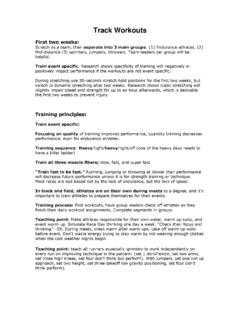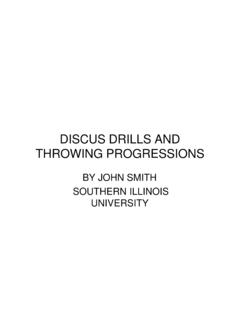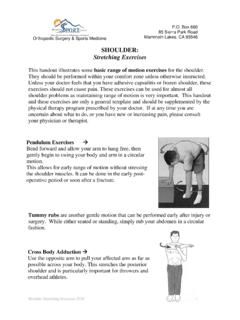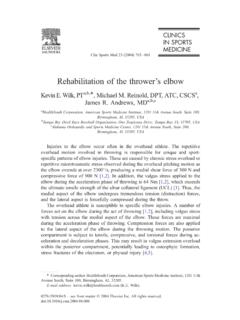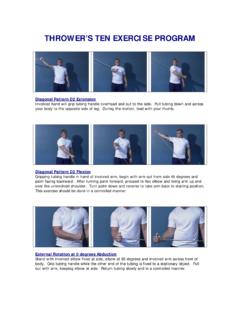Transcription of DISCUS THROWING 101 - Championship Productions
1 DISCUS THROWING 101. Colorado State University Brian Bedard HOW TO HOLD: The thrower should wrap the last digit of the fingers around the rim of the DISCUS with the palm of the hand near the center. The pointer and middle fingers should be together to give the thrower a good base in which to release from. The other fingers are spread slightly. STARTING POSITION: Feet should be shoulder width apart. This can be varied to help an athlete get into balanced position over the left foot. PRELIMINARY SWINGS: One preliminary swing should be plenty. Thrower should be as big as possible. Try to have a big wing-span . STAY TORQUED: Once the DISCUS is wound back in the preliminary swing it should stay back.
2 It should remain high and back off the shoulder through the entire throw. UPRIGHT POSITION: The back should remain straight with arms at maximum extension away from the center point of the body. The thrower shouldn't bend at waist during the throw. The bending should take place from the legs. INITIATE THE TURN: How does a thrower start? The left knee and arm should open up in the direction of the throw. The left arm should not pass the left knee. If the left arm is too active and passes the left knee, it will result in a fall to the middle of the circle. BALANCE POSITION OVER THE LEFT: The thrower shifts body weight over the left foot. The left armpit makes a path around the left foot.
3 This enables the thrower to pivot on the left while being on balance, decreasing the chances of falling to the middle. RIGHT LEG SWEEP: Once the left knee opens up and creates tension in the groin area, then the right foot moves out away from the body in a sweeping motion out of the back of the circle. The right knee and toes should be pointing up as the leg sweeps. This means that the inside of the leg is leading around. LEFT LEG PUNCH: Once the right leg passes the left leg the driving action must occur. I. refer to this as a sprint or punch off the back of the circle. The thrower should not get an over-extended lunge off the back. If the thrower gets over-extended while driving off the back, the left foot will be slow to touch down at the front of the circle.
4 This action will shorten working phase. PINCH THE KNEE: As the thrower drives off the left and becomes airborne the left knee needs to be pinched to the right knee. Why? The athlete should shorten the long left leg making it faster and more efficient to get down at the front. It will also increase rotational speed in the middle. FLIGHT PHASE: Be patient with the upper-body and head. In my experience as a coach, this is a big problem area for the young thrower. The athlete will try to do too much work in the air, instead of on the ground. I instruct the thrower to leave the DISCUS back and trailing and leave the chin with the chest. In other words, don't lead the throw with the eyes and the head.
5 THE SYSTEM: The thrower should stay in the original position when leaving the ground. Many throwers will try to hurry one part of the body or system ahead of another and it results in having to wait for the other to catch up. Hurrying the right leg, called pre-turning to the middle will advance this part of the system and cause a delay in waiting for the left side. Cranking the head and shoulders ahead of the legs will result in a stall, because the thrower must then wait for the legs to catch up to the upper- body. LANDING ON RIGHT: Keep the right foot under the knee in the air. Do not reach with the foot extending past the right knee. Why? The athlete will make contact too far out in front of their center, resulting in deceleration and inability to stay back over right leg.
6 Thrower must land on the ball of the foot in order to have continuous right foot turning. If the athlete collapses and goes to the flat of the foot it will result in difficulty rotating the right foot. RIGHT SIDE MUST KEEP TURNING: This may be one of the most important elements of the throw to stress to a young athlete. The right foot, knee, hip must rotate in the direction of the throw. It should be as continuous and aggressive as possible. KEEP THE DISCUS BACK: It is very important that the thrower keep the DISCUS locked back throughout the throw, not letting it creep up with the right hip and thus loosing the pull at the finish. In the preliminary swing the DISCUS should come back as far as possible and the arm should stay straight off the shoulder.
7 If the arm drops, radius is decreased and this will negatively affect distance. GET THE LEFT DOWN: Placing the left foot down at the front is also extremely important to getting a long pull. If the left takes a wide path to the front it will result in a late touch down, and the thrower looses pull on the DISCUS . It is very important to get two feet down with the DISCUS as far back as possible. POWER POSITION: This is when the left foot lands at the front of the circle in preparation for the release. The coach should constantly evaluate the power position. If the athlete is out of position the coach must trace it back several steps to find out where the problem originates.
8 Feet are shoulder width or slightly wider with the left foot being slightly left of the center line and the right foot on the center line LONG PULL: The German's have made a science of this aspect of DISCUS THROWING . Must Keep the DISCUS back as far as possible while the DISCUS travels through a wide radius. The goal is to work the DISCUS over the longest path possible. They are very flexible, disciplined and patient with the upper body. They let the legs do the work first, and at the right moment involve the upper-body. A long pull should be the ultimate goal of a DISCUS thrower. All else being equal, the thrower that works the DISCUS over the longest path will win every time.
9 RIGHT FOOT TURNING: To keep the right leg and hip ahead of the DISCUS , the thrower must turn the right foot, knee and hip in the direction of the throw. If this is not done, the throw will have a stall in the center and will loose power at the finish. Turning the right foot, knee and hip in the middle is a must for a long throw! If the DISCUS catches up with the hip, the release becomes a push instead of a pull. LEFT SIDE BLOCK: As the right side turns the left side should stop. The left leg needs to extend aggressively becoming rigid and the left arm should stop at the thrower's side with a bent elbow. If the arm and head don't stop and block, power will be lost through the left side and away from the DISCUS throw.
10 THE FINISH: The thrower should hang the DISCUS as far out to the right side as possible, this allows for the maximum radius possible. If a thrower tries to muscle the finish by shortening the right arm, it will decrease the radius and result in a shortened throw. The thrower's hips should be out and chest back while the chin is up. This action creates a natural arch of the back and will resemble a "C position. RIGHT EYE ON THE DISCUS : As the DISCUS is released, the thrower should make every effort to watch the DISCUS with the right eye. One of the most common problems with young throwers is turning away during the finish. It results in loosing the DISCUS early, down the right sector line and loosing power on the finish.
